For some reason my pictures uploaded to here upside down. If you click on the picture itself it will display as right side up. Who knows?
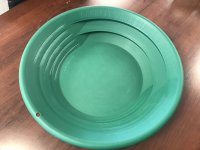
Hello Everyone,
I thought I would share the mods I’ve made to my Garrett super sluice. I really love my super sluice, the way the water and dirt moves inside of it is just something fantastic. My only problem with it is that the riffles are so aggressive that I always end up with way to many heavies. This makes it difficult while sampling to really see how much gold I am working with unless I take the time to finish it down further. Since I am usually trying to move quickly I know for a fact that I have lost some gold when doing this. Albeit fine gold usually but when this happens it doesn't necessarily inspire trust between me and my pan.
To fix this problem I made some additional riffles into the pan which seem to have helped quite a bit. I thought I would give instructions in case anyone else liked these mods.
TOOLS NEEDED
- Dremel
- Dremel etching tool # 194
- Fine Sandpaper
- Razor or knife (optional)
- Scissors, marker, and paper
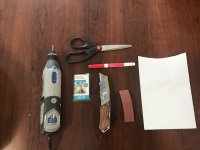
Step 1
To make a straight line on the on a curved pan you first have to make a straight edge. I did this by folding a sheet of paper in half ( this gave me the approximate length of the riffles as well). Press the paper on the middle existing riffle on the super sluice, this creates a fold on the paper and gives you a straight edge to use as a template on the curved surface of the pan. Cut along this fold line to finish your template.
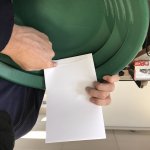
Step 2
Next, using your straight edge make a mark for where your riffles will be. You can have as many or as few as you like.
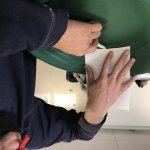
Step 3
Part of the genius of the super sluice is the angle on the riffles. This angle makes it very difficult for gold to climb over the riffles while letting the heavies easily fall back into the pan when it is dropped to re-stratify. You will need to find this angle for your smaller riffles. I did this by holding my Dremel stationary and adjusting the pan until the tool and the riffle angle were parallel.
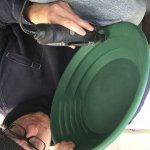
Step 4
Trying to keep approximately the same angle that you just found begin to etch along your lines that you marked. I found the best way to do this was to first score along the line and then go back and make a deeper cut. Finally I would do one more cut getting just a little bit deeper than the last 2 and cleaning up and imperfections. The sides of this pan are quite thick so don’t worry to much about puncturing the side of the pan, that being said I wouldn’t get carried away with the etching either.
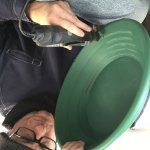
Step 4
Using the sandpaper remove any large burrs from the top of the riffles (don’t get carried away, you want a hard edge here). On the bottom of the riffles smooth out the bottom so that when you drop the pan level sand will easily flow back into the pan (you can get carried away here, on the bottom of each riffle).
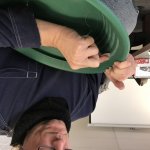
Step 5
Check your angles. Using your fingernails pull slightly downward on each of your riffles and see if you can pull on them (like gold running out of your pan). If your fingernails slide out with easy force then you did a mediocre job. It should still work however. It should catch your finger nails and hang onto them. Going the other way towards the bottom of your pan your fingernails should slide easily finding no purchase on the riffles.
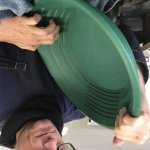
Step 6 (optional)
To make final cleanup easier you can repeat the above process but instead of using a Dremel and etching simply use a razor or a sharp knife. Your just scoring the side of the pan so don’t get to nuts here. I do this on the other side of the pan and I keep the rear of the pan as a smooth finish.
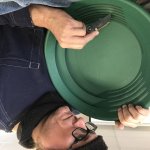
Best regards and good luck!!

Hello Everyone,
I thought I would share the mods I’ve made to my Garrett super sluice. I really love my super sluice, the way the water and dirt moves inside of it is just something fantastic. My only problem with it is that the riffles are so aggressive that I always end up with way to many heavies. This makes it difficult while sampling to really see how much gold I am working with unless I take the time to finish it down further. Since I am usually trying to move quickly I know for a fact that I have lost some gold when doing this. Albeit fine gold usually but when this happens it doesn't necessarily inspire trust between me and my pan.
To fix this problem I made some additional riffles into the pan which seem to have helped quite a bit. I thought I would give instructions in case anyone else liked these mods.
TOOLS NEEDED
- Dremel
- Dremel etching tool # 194
- Fine Sandpaper
- Razor or knife (optional)
- Scissors, marker, and paper

Step 1
To make a straight line on the on a curved pan you first have to make a straight edge. I did this by folding a sheet of paper in half ( this gave me the approximate length of the riffles as well). Press the paper on the middle existing riffle on the super sluice, this creates a fold on the paper and gives you a straight edge to use as a template on the curved surface of the pan. Cut along this fold line to finish your template.

Step 2
Next, using your straight edge make a mark for where your riffles will be. You can have as many or as few as you like.

Step 3
Part of the genius of the super sluice is the angle on the riffles. This angle makes it very difficult for gold to climb over the riffles while letting the heavies easily fall back into the pan when it is dropped to re-stratify. You will need to find this angle for your smaller riffles. I did this by holding my Dremel stationary and adjusting the pan until the tool and the riffle angle were parallel.

Step 4
Trying to keep approximately the same angle that you just found begin to etch along your lines that you marked. I found the best way to do this was to first score along the line and then go back and make a deeper cut. Finally I would do one more cut getting just a little bit deeper than the last 2 and cleaning up and imperfections. The sides of this pan are quite thick so don’t worry to much about puncturing the side of the pan, that being said I wouldn’t get carried away with the etching either.

Step 4
Using the sandpaper remove any large burrs from the top of the riffles (don’t get carried away, you want a hard edge here). On the bottom of the riffles smooth out the bottom so that when you drop the pan level sand will easily flow back into the pan (you can get carried away here, on the bottom of each riffle).

Step 5
Check your angles. Using your fingernails pull slightly downward on each of your riffles and see if you can pull on them (like gold running out of your pan). If your fingernails slide out with easy force then you did a mediocre job. It should still work however. It should catch your finger nails and hang onto them. Going the other way towards the bottom of your pan your fingernails should slide easily finding no purchase on the riffles.

Step 6 (optional)
To make final cleanup easier you can repeat the above process but instead of using a Dremel and etching simply use a razor or a sharp knife. Your just scoring the side of the pan so don’t get to nuts here. I do this on the other side of the pan and I keep the rear of the pan as a smooth finish.

Best regards and good luck!!
Amazon Forum Fav 👍
Upvote
0





